Gait Phase Detection Based on Muscle Deformation with Static Standing-Based Calibration
Abstract
1. Introduction
1.1. Background
1.2. Previous Research
1.3. Objective
- Establishing an easy and fast semi-automatic calibration method for gait phase detection using discrete static standing data with muscle deformation information;
- Enabling the use of a gait phase detection system with only one sensor.
- Conducting experiments with the novel gait phase detection system on humans.
2. Proposed System
2.1. Sensor
2.2. Classification Method
3. Experiment
3.1. Data Acquisition
3.2. Considering the Combination of Standing Data
3.3. Evaluation of Gait Phase Detection
4. Results and Discussion
5. Conclusions
Author Contributions
Funding
Institutional Review Board Statement
Informed Consent Statement
Data Availability Statement
Acknowledgments
Conflicts of Interest
Sample Availability
Abbreviations
| FSR | Force-sensing resistor |
| HMM | Hidden Markov model |
| IMU | Inertial measurement units |
| SVM | Support vector machine |
| EMG | Electromyography |
| LDA | Linear discriminant analysis |
| LR | Logistic regression |
| LR-a | Logistic regression with adjustment based on angular velocity of a sensor |
References
- Studenski, S.; Perera, S.; Patel, K.; Rosano, C.; Faulkner, K.; Inzitari, M.; Brach, J.; Chandler, J.; Cawthon, P.; Connor, E.B.; et al. Gait Speed and Survival in Older Adults. JAMA 2011, 305, 50–58. [Google Scholar] [CrossRef]
- Pirker, W.; Katzenschlager, R. Gait disorders in adults and the elderly: A clinical guide. Wien. Klin. Wochenschr. 2017, 129, 81–95. [Google Scholar] [CrossRef]
- Beauchet, O.; Allali, G.; Berrut, G.; Hommet, C.; Dubost, V.; Assal, F. Gait analysis in demented subjects: Interests and perspectives. Exp. Gerontol. 2008, 4, 110625. [Google Scholar] [CrossRef]
- Grande, G.; Triolo, F.; Nuara, A.; Welmer, A.K.; Fratiglioni, L.; Vetrano, D.L. Measuring gait speed to better identify prodromal dementia. Neuropsychiatr. Dis. Treat. 2019, 124, 155–160. [Google Scholar] [CrossRef]
- Martini, E.; Crea, S.; Parri, A.; Bastiani, L.; Faraguna, U.; McKinney, Z.; Molino-Lova, R.; Pratali, L.; Vitiello, N. Gait training using a robotic hip exoskeleton improves metabolic gait efficiency in the elderly. Sci. Rep. 2019, 9, 7157. [Google Scholar] [CrossRef]
- Miyake, T.; Kobayashi, Y.; Fujie, M.G.; Sugano, S. Effect of the timing of force application on the toe trajectory in the swing phase for a wire-driven gait assistance robot. Mech. Eng. J. 2018, 5, 17-00660. [Google Scholar] [CrossRef]
- Perry, J. Gait Analysis: Normal and Pathological Function; SLACK Incorporated: Thorofare, NJ, USA, 1992; pp. 3–50. [Google Scholar]
- O’Connor, C.; Thorpe, S.; O’Malley, M.; Vaughan, C. Automatic detection of gait events using kinematic data. Gait Posture 2007, 25, 469–474. [Google Scholar] [CrossRef]
- Hanlon, M.; Anderson, R. Real-time gait event detection using wearable sensors. Gait Posture 2009, 30, 523–527. [Google Scholar] [CrossRef] [PubMed]
- Hausdorff, J.M.; Ladin, Z.; Wei, J.Y. Footswitch system for measurement of the temporal parameters of gait. J. Biomech. 1995, 28, 347–351. [Google Scholar] [CrossRef]
- Mills, P.; Barrett, R.; Morrison, S. Agreement between footswitch and ground reaction force techniques for identifying gait events: Inter-session repeatability and the effect of gait speed. Gait Posture 2007, 26, 323–326. [Google Scholar] [CrossRef] [PubMed]
- Catalfamo, P.; Moser, D.; Ghoussayni, S.; Ewins, D. Detection of gait events using an F-Scan in-shoe pressure measurement system. Gait Posture 2008, 28, 420–426. [Google Scholar] [CrossRef]
- Smith, B.T.; Coiro, D.J.; Finson, R.; Betz, R.R.; McCarthy, J. Evaluation of force-sensing resistors for gait event detection to trigger electrical stimulation to improve walking in the child with cerebral palsy. IEEE Trans. Neural Syst. Rehabil. Eng. 2002, 10, 229. [Google Scholar]
- Tang, J.; Zheng, J.; Wang, Y.; Yu, L.; Zhan, E.; Song, Q. Self-Tuning Threshold Method for Real-Time Gait Phase Detection Based on Ground Contact Forces Using FSRs. Sensors 2018, 18, 481. [Google Scholar] [CrossRef]
- Yu, L.; Zheng, J.; Wang, Y.; Song, Z.; Zhan, E. Adaptive method for real-time gait phase detection based on ground contact forces. Gait Posture 2015, 41, 269–275. [Google Scholar] [CrossRef] [PubMed]
- Ding, S.; Ouyang, X.; Li, Z.; Yang, H. Proportion-based fuzzy gait phase detection using the smart insole. Sens. Actuators A Phys. 2018, 284, 96–102. [Google Scholar] [CrossRef]
- Bae, J.; Tomizuka, M. Gait phase analysis based on a Hidden Markov Model. Mechatronics 2011, 21, 961–970. [Google Scholar] [CrossRef]
- Lee, J.K.; Park, E.J. Quasi real-time gait event detection using shank-attached gyroscopes. Med. Biol. Eng. Comput. 2011, 49, 707–712. [Google Scholar] [CrossRef] [PubMed]
- Taborri, J.; Rossi, S.; Palermo, E.; Patanè, F.; Cappa, P. A Novel HMM Distributed Classifier for the Detection of Gait Phases by Means of a Wearable Inertial Sensor Network. Sensors 2014, 14, 16212–16234. [Google Scholar] [CrossRef] [PubMed]
- Mannini, A.; Genovese, V.; Maria Sabatini, A. Online Decoding of Hidden Markov Models for Gait Event Detection Using Foot-Mounted Gyroscopes. IEEE J. Biomed. Health Inform. 2014, 18, 1122–1130. [Google Scholar] [CrossRef] [PubMed]
- Sánchez Manchola, M.D.S.; Pinto Bernal, M.J.P.; Munera, M.; Cifuentes, C.A. Gait Phase Detection for Lower-Limb Exoskeletons using Foot Motion Data from a Single Inertial Measurement Unit in Hemiparetic Individuals. Sensors 2019, 19, 2988. [Google Scholar] [CrossRef]
- Mannini, A.; Trojaniello, D.; Cereatti, A.; Sabatini, A. A Machine Learning Framework for Gait Classification Using Inertial Sensors: Application to Elderly, Post-Stroke and Huntington’s Disease Patients. Sensors 2016, 16, 134. [Google Scholar] [CrossRef] [PubMed]
- Aung, M.S.H.; Thies, S.B.; Kenney, L.P.J.; Howard, D.; Selles, R.W.; Findlow, A.H.; Goulermas, J.Y. Automated Detection of Instantaneous Gait Events Using Time Frequency Analysis and Manifold Embedding. IEEE Trans. Neural Syst. Rehabil. Eng. 2013, 21, 908–916. [Google Scholar] [CrossRef]
- Su, B.; Wang, J.; Liu, S.; Sheng, M.; Jiang, J.; Xiang, K. A CNN-Based Method for Intent Recognition Using Inertial Measurement Units and Intelligent Lower Limb Prosthesis. IEEE Trans. Neural Syst. Rehabil. Eng. 2019, 27, 1032–1042. [Google Scholar] [CrossRef]
- Zhen, T.; Yan, L.; Yuan, P. Walking Gait Phase Detection Based on Acceleration Signals Using LSTM-DNN Algorithm. Algorithms 2019, 12, 253. [Google Scholar] [CrossRef]
- Liu, M.; Zhang, F.; Huang, H.H. An Adaptive Classification Strategy for Reliable Locomotion Mode Recognition. Sensors 2017, 17, 2020. [Google Scholar] [CrossRef]
- Nazmi, N.; Rahman, M.A.A.; Yamamoto, S.I.; Ahmad, S.A. Walking gait event detection based on electromyography signals using artificial neural network. Biomed. Signal Process. Control 2019, 47, 334–343. [Google Scholar] [CrossRef]
- Peng, F.; Peng, W.; Zhang, C.; Zhong, D. IoT Assisted Kernel Linear Discriminant Analysis Based Gait Phase Detection Algorithm for Walking With Cognitive Tasks. IEEE Access 2019, 7, 68240–68249. [Google Scholar] [CrossRef]
- Jiang, X.; Chu, K.; Khoshnam, M.; Menon, C. A Wearable Gait Phase Detection System Based on Force Myography Techniques. Sensors 2018, 18, 1279. [Google Scholar] [CrossRef]
- Liu, D.X.; Wu, X.; Du, W.; Wang, C.; Xu, T. Gait Phase Recognition for Lower-Limb Exoskeleton with Only Joint Angular Sensors. Sensors 2016, 16, 1579. [Google Scholar] [CrossRef] [PubMed]
- Miyake, T.; Kobayashi, Y.; Fujie, M.G.; Sugano, S. Gait event detection based on inter-joint coordination using only angular information. Adv. Robot. 2020, 34, 1190–1200. [Google Scholar] [CrossRef]
- Allseits, E.; Lučarević, J.; Gailey, R.; Agrawal, V.; Gaunaurd, I.; Bennett, C. The development and concurrent validity of a real-time algorithm for temporal gait analysis using inertial measurement units. J. Biomech. 2017, 55, 27–33. [Google Scholar] [CrossRef] [PubMed]
- Pérez-Ibarra, J.C.; Siqueira, A.A.G.; Krebs, H.I. Real-Time Identification of Gait Events in Impaired Subjects Using a Single-IMU Foot-Mounted Device. IEEE Sens. J. 2020, 20, 2616–2624. [Google Scholar] [CrossRef]
- Zhong, Y.; Deng, Y. Sensor orientation invariant mobile gait biometrics. In Proceedings of the IEEE International Joint Conference on Biometrics, Clearwater, FL, USA, 29 September–2 October 2014; pp. 1–8. [Google Scholar] [CrossRef]
- Miyake, T.; Cheng, Z.; Hosono, S.; Yamamoto, S.; Funabashi, S.; Zhang, C.; Tamaki, E. Heel-Contact Gait Phase Detection Based on Specific Poses with Muscle Deformation. In Proceedings of the 2019 IEEE International Conference on Robotics and Biomimetics (ROBIO), Dali, China, 6–8 December 2019; pp. 977–982. [Google Scholar] [CrossRef]
- H2L. H2L Homepage, 2019. Available online: http://h2l.jp/en/homepage-main/ (accessed on 25 November 2020).
- Diebel, J. Representing Attitude: Euler Angles, Unit Quaternions, and Rotation Vectors; Technical Report; Stanford University: Stanford, CA, USA, 2006; pp. 94301–99010. [Google Scholar]
- Belbasis, A.; Fuss, F.K. Muscle Performance Investigated With a Novel Smart Compression Garment Based on Pressure Sensor Force Myography and Its Validation Against EMG. Front. Physiol. 2018, 9, 408. [Google Scholar] [CrossRef] [PubMed]
- Grushko, S.; Spurný, T.; Černý, M. Control Methods for Transradial Prostheses Based on Remnant Muscle Activity and Its Relationship with Proprioceptive Feedback. Sensors 2020, 20, 4883. [Google Scholar] [CrossRef] [PubMed]
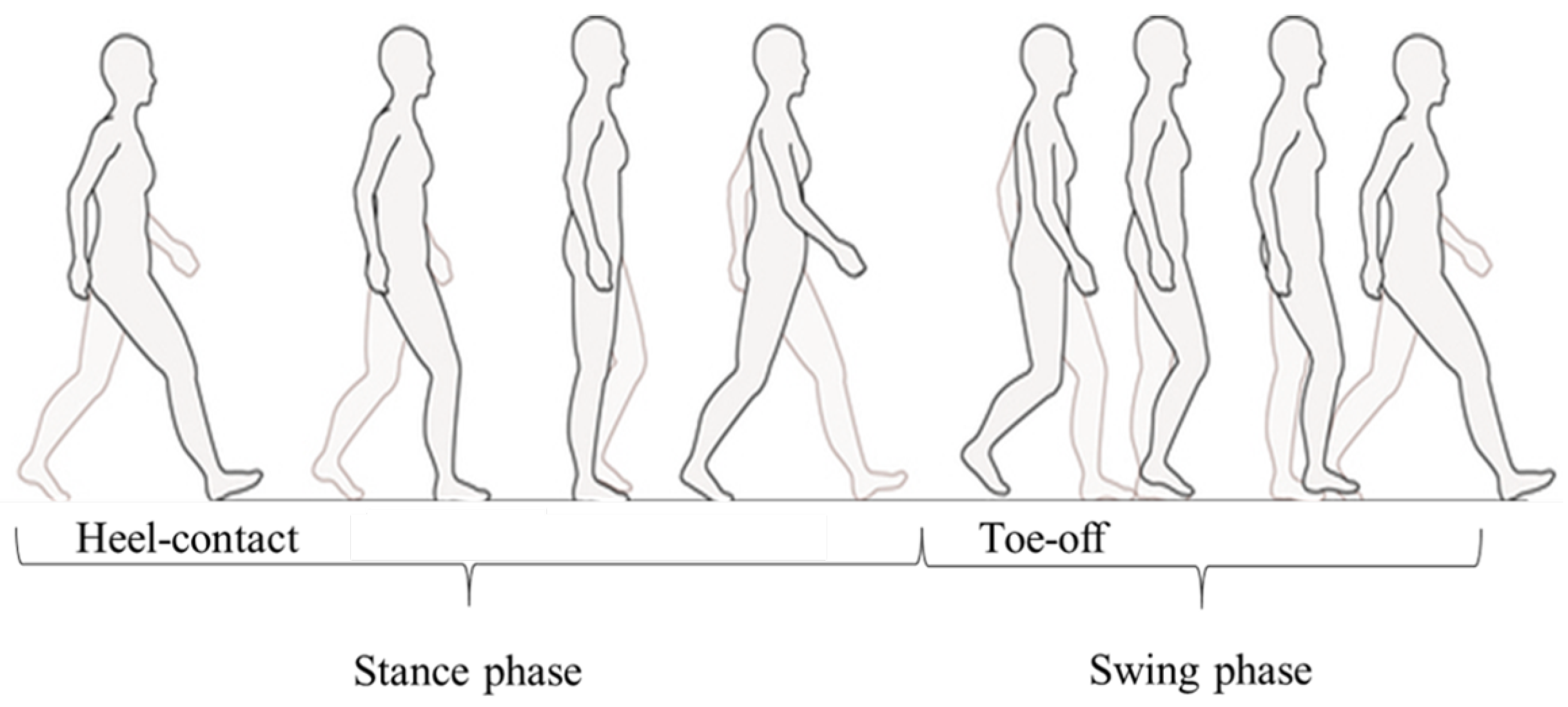
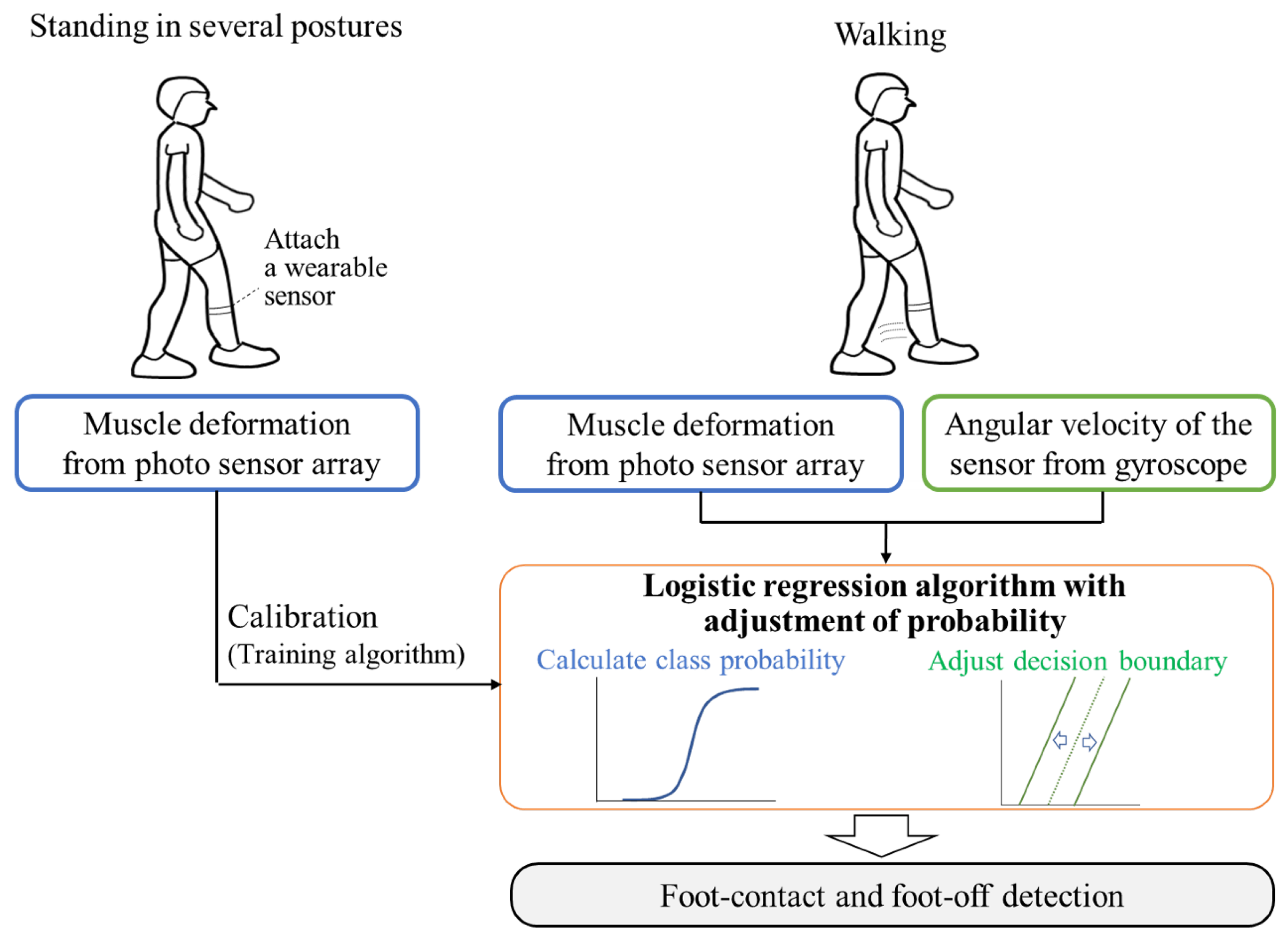
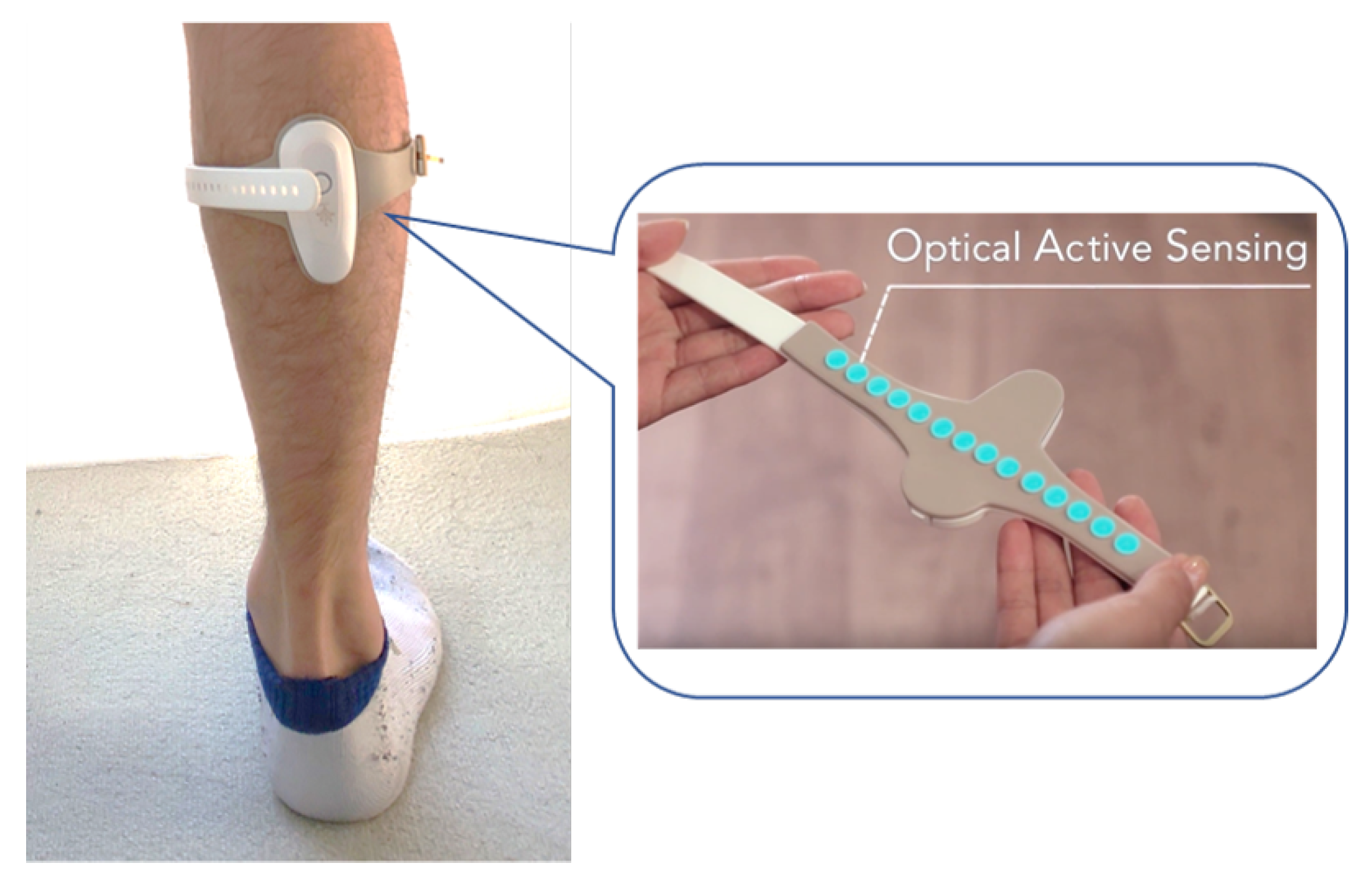

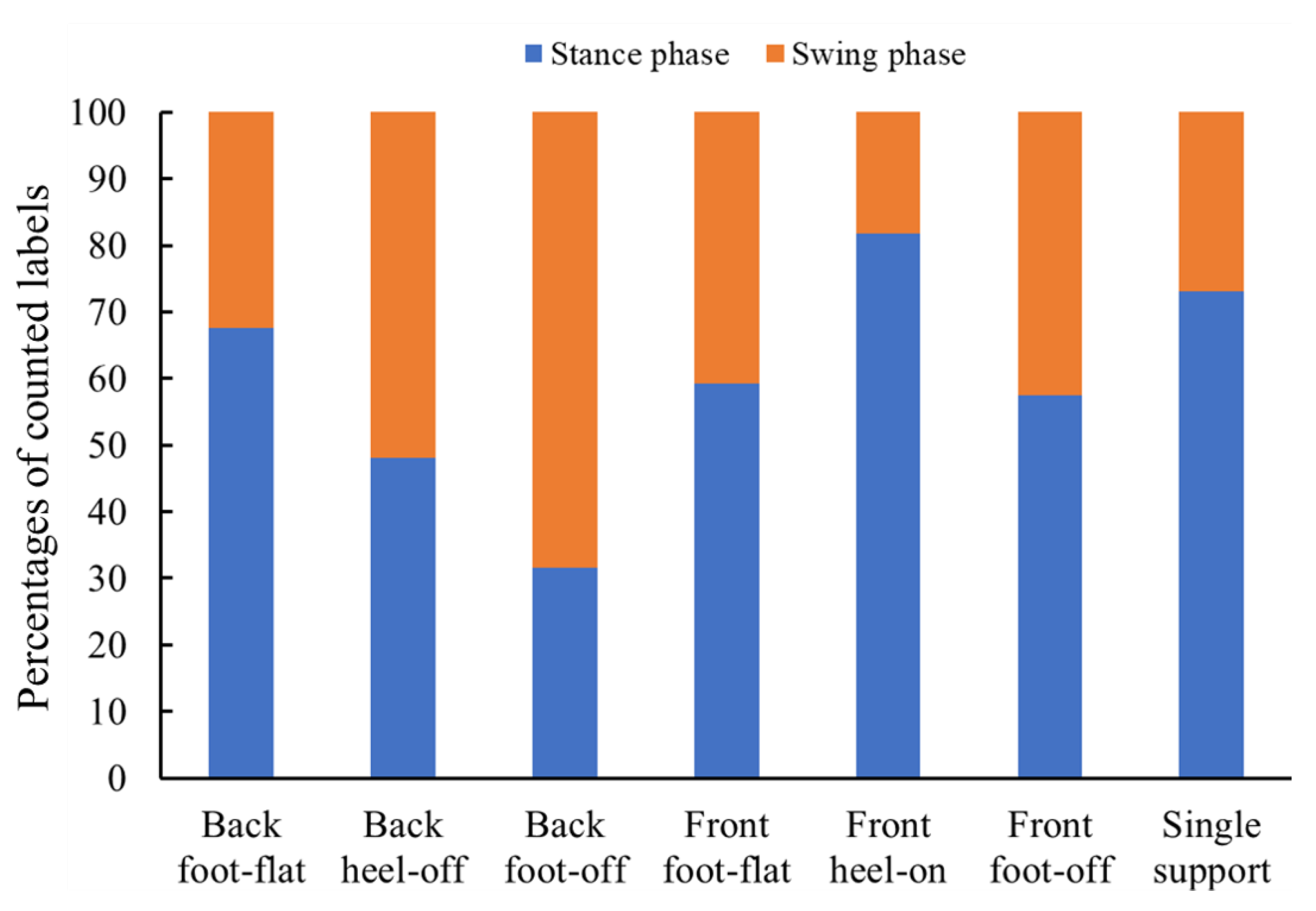
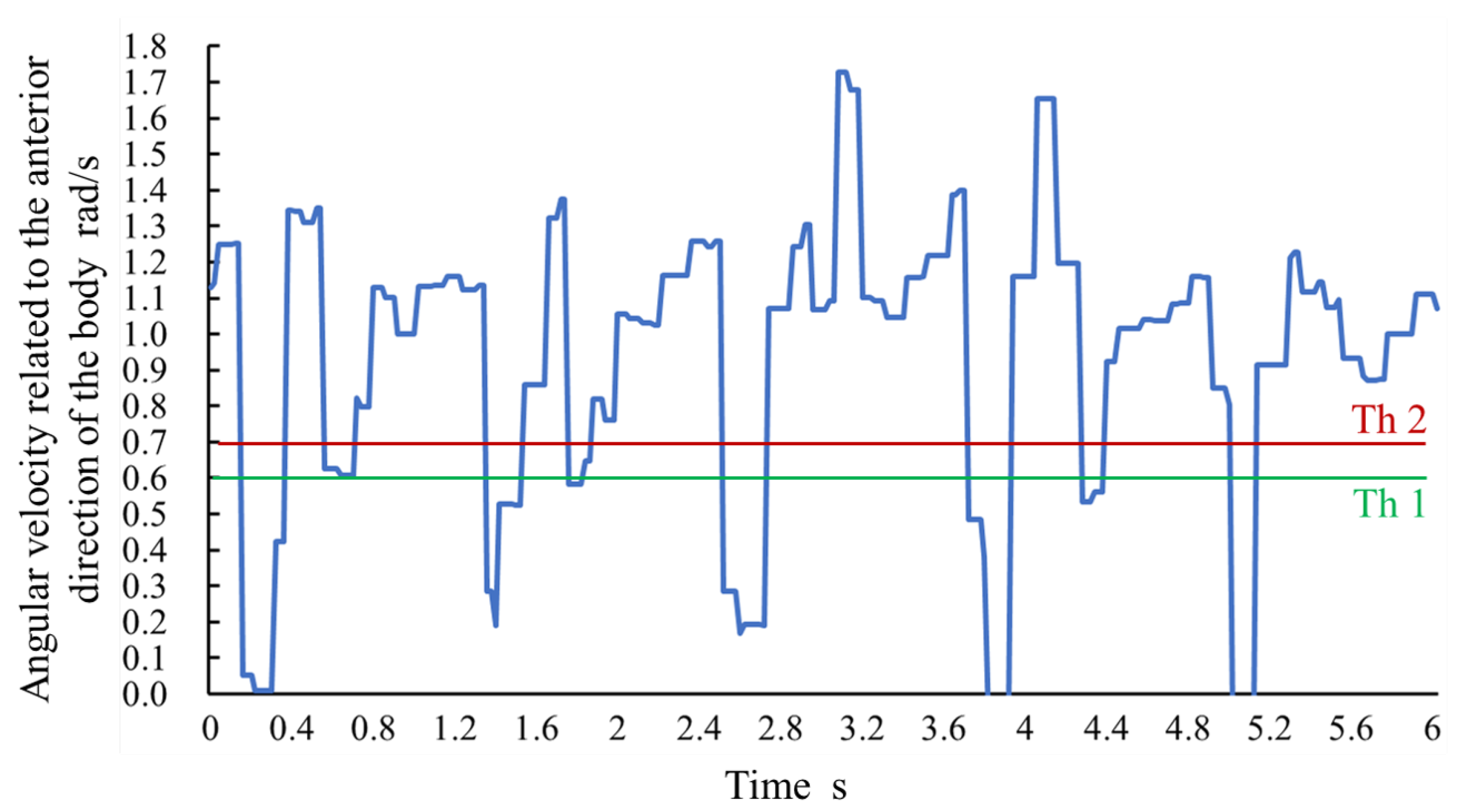

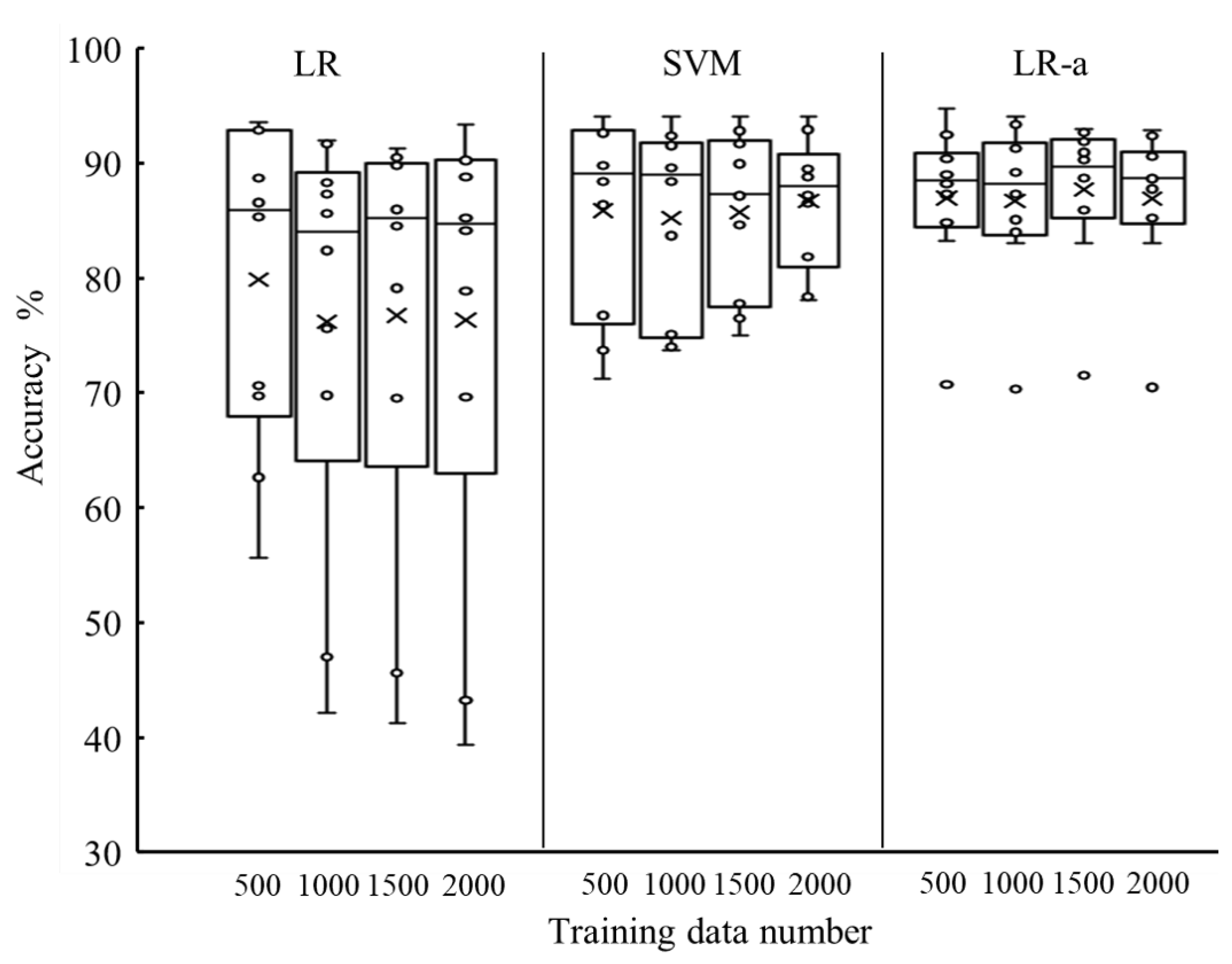
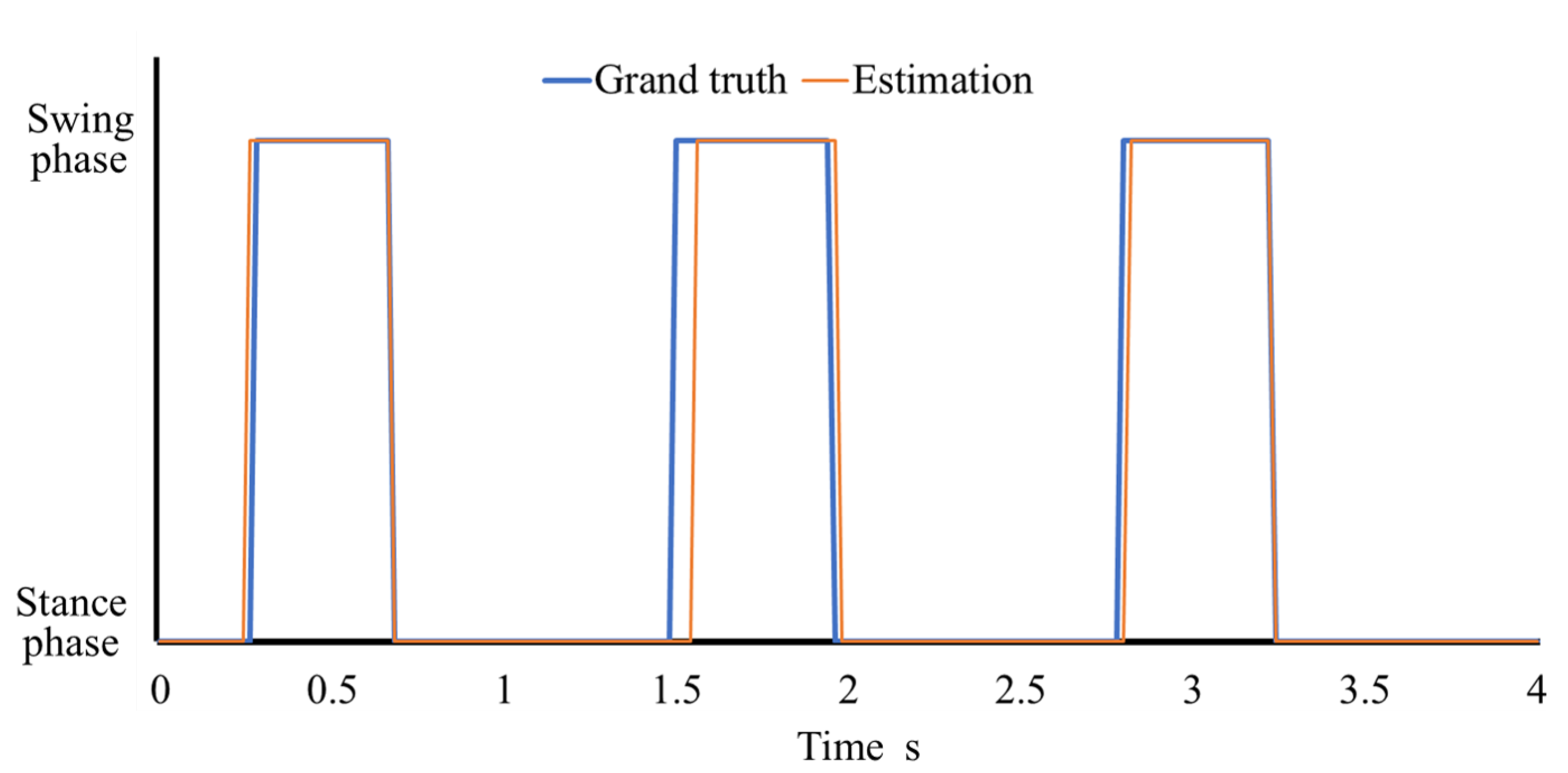
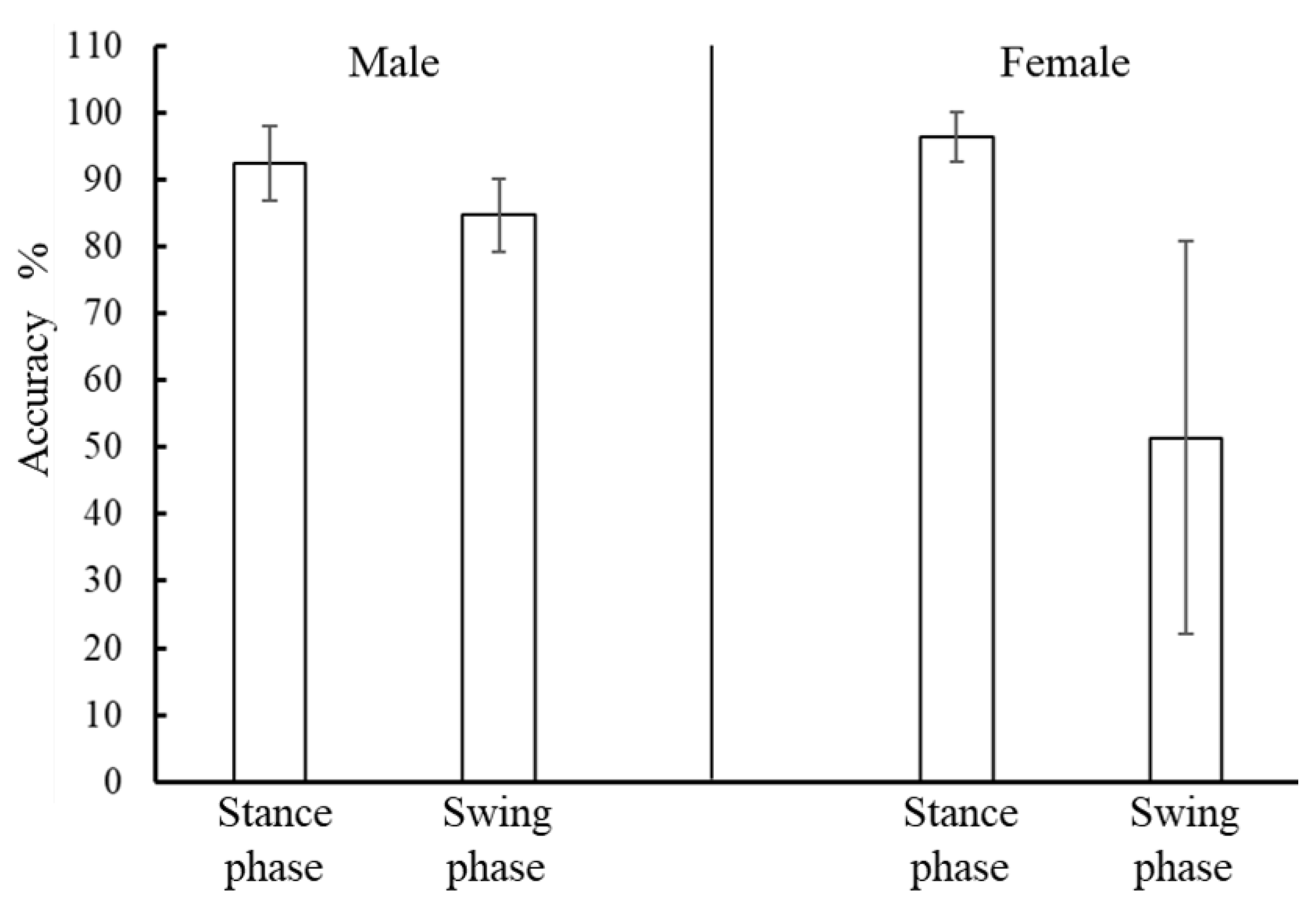
| Condition | Swing Postures | Stance Postures | |||||
|---|---|---|---|---|---|---|---|
| Back Foot-Off | Front Foot-Off | Front Heel-On | Single Support | Back Foot-On | Front Foot-On | Back Heel-Off | |
| 1 | used | - | used | - | - | - | - |
| 2 | used | - | used | used | - | - | - |
| 3 | used | - | used | used | used | - | - |
| 4 | used | - | used | used | used | used | - |
| 5 | used | - | used | used | used | used | used |
| 6 | used | used | used | - | - | - | - |
| 7 | used | used | used | used | - | - | - |
| 8 | used | used | used | used | used | - | - |
| 9 | used | used | used | used | used | used | - |
| 10 | used | used | used | used | used | used | used |
| Training Data Number | True Positive Rate of Stance Phase % | True Positive Rate of Swing Phase % | ||
|---|---|---|---|---|
| Median | IQR | Median | IQR | |
| 500 | 95 | 6 | 81 | 25 |
| 1000 | 93 | 10 | 84 | 17 |
| 1500 | 95 | 6 | 79 | 17 |
| 2000 | 93 | 11 | 81 | 21 |
Publisher’s Note: MDPI stays neutral with regard to jurisdictional claims in published maps and institutional affiliations. |
© 2021 by the authors. Licensee MDPI, Basel, Switzerland. This article is an open access article distributed under the terms and conditions of the Creative Commons Attribution (CC BY) license (http://creativecommons.org/licenses/by/4.0/).
Share and Cite
Miyake, T.; Yamamoto, S.; Hosono, S.; Funabashi, S.; Cheng, Z.; Zhang, C.; Tamaki, E.; Sugano, S. Gait Phase Detection Based on Muscle Deformation with Static Standing-Based Calibration. Sensors 2021, 21, 1081. https://doi.org/10.3390/s21041081
Miyake T, Yamamoto S, Hosono S, Funabashi S, Cheng Z, Zhang C, Tamaki E, Sugano S. Gait Phase Detection Based on Muscle Deformation with Static Standing-Based Calibration. Sensors. 2021; 21(4):1081. https://doi.org/10.3390/s21041081
Chicago/Turabian StyleMiyake, Tamon, Shintaro Yamamoto, Satoshi Hosono, Satoshi Funabashi, Zhengxue Cheng, Cheng Zhang, Emi Tamaki, and Shigeki Sugano. 2021. "Gait Phase Detection Based on Muscle Deformation with Static Standing-Based Calibration" Sensors 21, no. 4: 1081. https://doi.org/10.3390/s21041081
APA StyleMiyake, T., Yamamoto, S., Hosono, S., Funabashi, S., Cheng, Z., Zhang, C., Tamaki, E., & Sugano, S. (2021). Gait Phase Detection Based on Muscle Deformation with Static Standing-Based Calibration. Sensors, 21(4), 1081. https://doi.org/10.3390/s21041081







